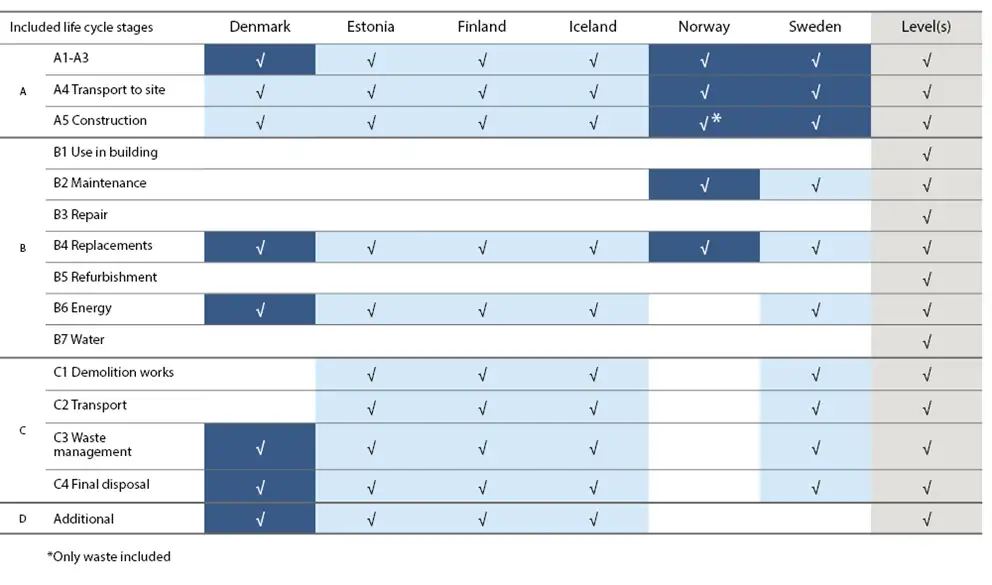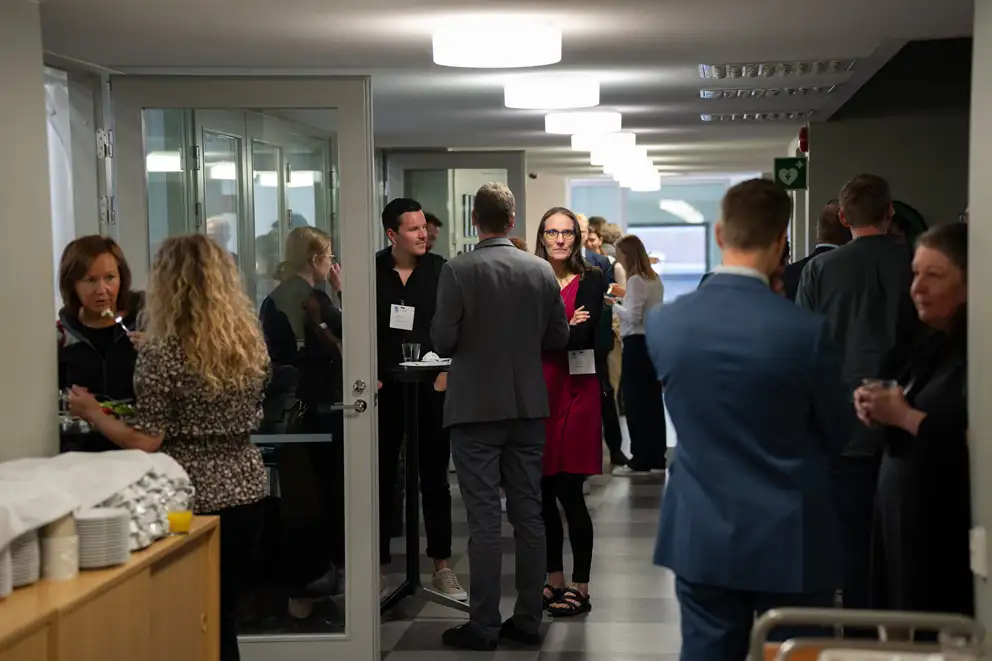Watch the live recording and browse through the presentations here
Policy Overview from the European Commission
Philippe Moseley, Policy Officer in DG GROW at the EU Commission, gave an EU policy overview regarding low carbon construction. This included recent updates on the Transition Pathway for Construction, the EPBD revision, CPR (construction products regulation) review, the Whole Life Carbon Roadmap, and Level(s).
You can watch Philippe’s presentation here or read more about the EU Commission’s work on EPBD, the Whole Life Carbon Roadmap, Transitions pathway for Construction and the EU Taxonomy here
How are the Nordic Countries and Estonia Implementing Policies on Low Carbon Construction?

Overview of the included life-cycle modules (according to standard EN15978) in the current introduced or proposed national building LCA models and in Level(s). The darker blue indicates what is already implemented or will be implemented while the lighter blue indicates proposed scope of future regulation
Norway
In spring 2023, Norway initiated a climate partnership with stakeholders from the construction sector. The goal is to develop a knowledge base through workshops. From summer 2023, it became mandatory to use the Norwegian standard NS 370:2018 for Green House Gas (GHG) emission calculation from construction. The GHG calculation should include LCA phases A1-A3, A4, B2, B4 and waste from construction sites.
In Norway they also have a focus on reducing fossil fuel regarding construction and housing. In addition, products suitable for reuse and material recovery shall be chosen over others. Lastly, from July 2023 buildings must be designed and built with subsequent dismantling in mind as far as possible
Finland
Finland plans to introduce a new construction act from January 1st 2025 which will include Whole Life Carbon regulation. The act seeks to lower carbon in construction and requires life cycle assessments and material declarations, incl. buildings components and origin of construction materials. The Whole Life Carbon limit values will include LCA phases A1-A5, B1-B8 and C1-C4 accounted for 50 years life span.
Sweden
In January 2022, Sweden implemented climate declarations for new buildings where developers are responsible for declaring climate impact for all products in LCA phases A1-A5. However, single family houses and buildings below 1000 square meters are excluded.
This summer, the Swedish National Board of Housing, Building and Planning proposed limit values for GHG emission from 2025 to the Swedish government. They also proposed extended limit values from 2027 with full life cycle phases and the same building elements. You can read about Sweden’s proposal for limit values in 2025 here.
Iceland
In Iceland, they have made a Roadmap to Sustainable Construction which sets 74 actions and goals for 2030. Furthermore, Iceland expects to introduce limit values for climate impact of buildings during 2024. Read about the Icelandic roadmap here.
Denmark
Denmark introduced climate declarations and limit values for climate impact of buildings in January 2023. Furthermore, Denmark expects to tighten these limit values in 2025. Learn more about Denmark’s climate requirements here.
Estonia
Estonia is committed to reducing carbon footprint and has set a National goal of climate neutrality by 2050 and 100% renewable electricity by 2030. Estonia plans to introduce mandatory LCA calculation for new buildings in 2025 and implement their first ever climate law by 2024. This law will promote green economy and competitiveness and define GHG emission and climate targets.

Carbon budgets for buildings
Embodied Carbon Emissions and How to Tame them
Dr. Martin Röck, Research Associate at KU Leuven, presented his work on whole life carbon, embodied carbon and LCA modelling of the European building stock.
In his studies, Whole life carbon emissions experiences a declining trend due to energy efficiency. At the same time, embodied GHG-emissions are increasing and take up the largest part of WLC of new and renovated buildings. Therefore, embodied carbon is crucial to decrease. Furthermore, his studies show that the European building stock emits around 40% of EU emissions (in 2020) where 71% are embodied emissions upfront.
Lastly, in an EU perspective Martin Röck underlined the importance of a more holistic effort. This includes decarbonising space heating, high renovation rates and depths, more circularity and increased use of bio-materials, improve ‘shift and avoid’ of material use, and use of existing buildings.
How can Decarbonisation of Nordic Building Stock happen in a Harmonised way?
Morten Walbech Ryberg, Senior Specialist at SWECO Denmark introduced the project on limit values and decarbonisation of the Nordic building stock, which is a part of the Nordic Sustainable Construction programme.
Read about the project on limit values and decarbonisation of Nordic building stock here.
Learnings from Implementing Limit Values in Denmark
Helle Redder Momsen, Special consult at the Danish Authority of Social Services and Housing gave an overview of Denmark’s experiences LCA legislation.
The Danish path to implementing limit values was initiated by the Nordic collaboration on low carbon construction in 2019. On this basis, climate partnerships with the construction sector and the Danish government were created, BUILD AAU did a case study on LCA, and in 2021 the Danish National Strategy for Sustainable Construction was produced. The limit values were send in EU notification and implemented in January 2023.
The current Danish legislation and LCA method are based on standard EN15978 and includes LCA modules A1-A3, B4, B6, C3-4 and D. Lessons learned have been that it is challenging to ensure systemic collection of data to gain experience and high quality calculations of LCA. However, an open dialogue with the construction sector, tools and transparency of coming regulations are helpful. In Denmark, it has also been clear how legislation spurs change while the industry creates networks on their own.
In Denmark, the aim is to tighten limit values every second year. This means that in 2015 1/3 of the construction sector needs to change practice, while in 2027 this will be ¾ and in 2029 it will be 9/10 of the sector. Future focus points are renovations and reuse.
Quotes from Business Outlooks of Carbon Neutral Construction
The forum also included a look into the Nordic carbon neutral construction from a business perspective. The main points were:
Anders Stouge, Chief Executive Director of The Danish Construction Federation, Denmark: “The EU taxonomy is one of the biggest drivers for change in the construction sector. We’re in a test period with trial and error in the Danish construction sector. It is important to consider EU, CPR and the EU taxonomy in relation to the Danish legislation”.
Charlotte Nyholm, Chief Specialist, Granlund, Finland: “Setting sustainability targets are criteria metric in procurement. Clients hold a lot of power – set targets and follow up!”
Katarzyna Jagodzinska, Project manager at Green Building Council Iceland: “In Iceland the construction market is highly motivated to reduce carbon footprint and increase sustainability. The main effort is put into reducing use of materials, as 43 % of climate emission come from LCA phase A1-A3 in Iceland.”